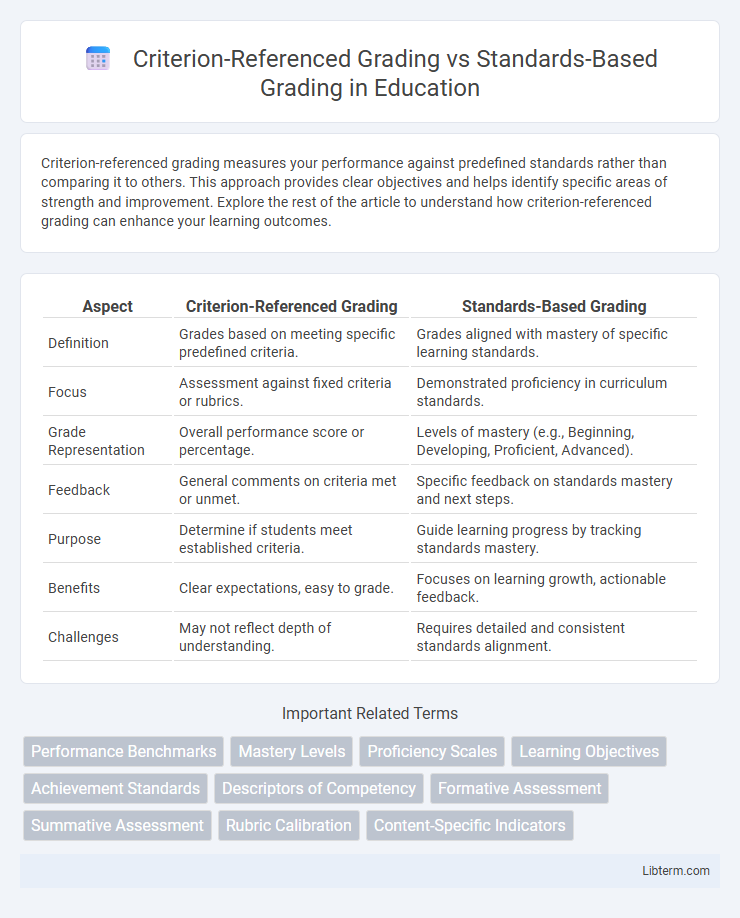Criterion-referenced grading measures your performance against predefined standards rather than comparing it to others. This approach provides clear objectives and helps identify specific areas of strength and improvement. Explore the rest of the article to understand how criterion-referenced grading can enhance your learning outcomes.
Table of Comparison
| Aspect | Criterion-Referenced Grading | Standards-Based Grading |
|---|---|---|
| Definition | Grades based on meeting specific predefined criteria. | Grades aligned with mastery of specific learning standards. |
| Focus | Assessment against fixed criteria or rubrics. | Demonstrated proficiency in curriculum standards. |
| Grade Representation | Overall performance score or percentage. | Levels of mastery (e.g., Beginning, Developing, Proficient, Advanced). |
| Feedback | General comments on criteria met or unmet. | Specific feedback on standards mastery and next steps. |
| Purpose | Determine if students meet established criteria. | Guide learning progress by tracking standards mastery. |
| Benefits | Clear expectations, easy to grade. | Focuses on learning growth, actionable feedback. |
| Challenges | May not reflect depth of understanding. | Requires detailed and consistent standards alignment. |
Introduction to Grading Systems
Criterion-Referenced Grading assesses student performance by comparing their work against predefined criteria or learning objectives, ensuring that grading reflects mastery of specific skills or knowledge. Standards-Based Grading evaluates students based on their proficiency relative to established educational standards, emphasizing ongoing progress and clarity in learning goals. Both systems aim to provide more meaningful and transparent feedback than traditional grading methods rooted in norm-referenced comparisons.
Defining Criterion-Referenced Grading
Criterion-Referenced Grading assesses student performance by measuring mastery of specific learning objectives rather than comparing scores to peer performance. It involves clear criteria established before instruction, enabling educators to evaluate whether students meet predetermined standards. This method emphasizes individual achievement and mastery over relative ranking, promoting targeted feedback and personalized learning paths.
Understanding Standards-Based Grading
Standards-Based Grading (SBG) evaluates student performance based on clear, predefined learning standards, providing specific feedback on mastery rather than averaging scores over time like Criterion-Referenced Grading. SBG emphasizes skill proficiency and growth by categorizing achievement levels, enabling educators to identify areas needing improvement and tailor instruction accordingly. This approach fosters deeper understanding and promotes a more accurate measure of student learning aligned with curriculum objectives.
Key Differences Between the Two Approaches
Criterion-referenced grading evaluates student performance based on predefined criteria or learning objectives, measuring mastery of specific skills or knowledge regardless of peer performance. Standards-based grading assesses students against established academic standards, categorizing proficiency levels such as beginning, developing, proficient, and advanced to provide detailed feedback on their progress. The key difference lies in criterion-referenced grading's focus on meeting specific benchmarks, while standards-based grading emphasizes tracking growth relative to grade-level expectations.
Advantages of Criterion-Referenced Grading
Criterion-Referenced Grading offers clear advantages by measuring student performance against fixed standards, ensuring consistent and objective evaluation regardless of peer performance. This method provides precise feedback on individual mastery of specific skills or content, facilitating targeted interventions and personalized learning plans. By emphasizing predetermined criteria, it promotes transparency and accountability, empowering both educators and students to track academic progress effectively.
Benefits of Standards-Based Grading
Standards-Based Grading (SBG) provides clear, focused feedback on student mastery of specific learning objectives, enhancing transparency and guiding targeted instruction. It promotes consistency by aligning grades directly with consistent academic standards rather than relative performance or point accumulation, offering a more accurate reflection of student learning. This approach supports personalized learning pathways, enabling educators to identify and address individual skill gaps effectively.
Challenges and Limitations of Both Systems
Criterion-referenced grading faces challenges in ensuring consistent interpretation of criteria across different educators, leading to variability in student assessment outcomes. Standards-based grading encounters limitations such as the complexity of aligning detailed standards with diverse curricula and the difficulty in capturing holistic student performance beyond specific benchmarks. Both systems require extensive teacher training and robust assessment design to mitigate issues related to fairness, transparency, and accurately reflecting student learning progress.
Impact on Student Assessment and Learning
Criterion-Referenced Grading evaluates student performance against a fixed set of criteria, providing clear benchmarks for mastery but sometimes limiting feedback on student growth. Standards-Based Grading emphasizes proficiency in specific learning standards, promoting detailed insight into student strengths and areas needing improvement, which supports targeted instruction and personalized learning. This approach fosters deeper understanding and continuous progress, aligning assessment with educational goals and improving overall student achievement.
Practical Implementation in Classrooms
Criterion-referenced grading assesses student performance against a fixed set of standards, enabling clear identification of mastery in specific skills or knowledge areas, which facilitates targeted interventions. Standards-based grading emphasizes measuring student progress toward specific learning goals through detailed rubrics and evidence collection, promoting personalized feedback and continuous improvement. In practical classroom implementation, both systems require consistent alignment of assessments with learning objectives, detailed record-keeping, and clear communication with students and parents to effectively track and support student growth.
Choosing the Right Grading System for Schools
Choosing the right grading system for schools involves evaluating Criterion-Referenced Grading (CRG) and Standards-Based Grading (SBG) based on educational goals and student assessment needs. CRG measures student performance against set criteria, providing clear benchmarks for mastery, while SBG emphasizes proficiency in specific standards, offering detailed feedback on strengths and areas for improvement. Schools prioritizing individualized learning and transparent progress tracking may benefit more from SBG, whereas institutions focused on uniform assessment outcomes often prefer CRG.
Criterion-Referenced Grading Infographic

 libterm.com
libterm.com